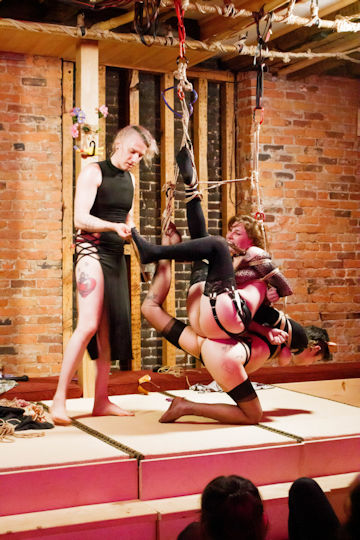Montreal shibari practitioners are reaching new heights and new audiences
Roughly 70 people travelled to the Village to attend Tension’s 70th shibari night.
Source: Thelinknewspaper.ca
CANADA – MONTREAL – Their doors opened at 8 p.m. and guests flooded into the entry, taking their shoes off and neatly tucking them away before entering the studio’s seating area.

‘Shibari,’ meaning “to tie” or “to bind,” is a form of rope bondage that originated in Japan dating back to the medieval and Edo periods. Originally used to restrain captives as a form of torture, it is now mostly known for its use in kink communities and in pornography.
There are a variety of roles a person can take in shibari. Riggers are people who tie up bottoms, ensuring their safety and well-being. Bottoms are the individuals being tied up, and switches are those who alternate between both roles. Individuals or groups who work together regularly or in a class are referred to as tying partners.

Owners Willcat, Katmiss and Cwiss offer courses ranging from tying to communication, as well as performance events and kinky craft fairs.
Willcat has been tying since 2015 and said that, in the last decade, shibari has shifted towards performance art, but still is a very sexual practice.
Twofingers, a private-practice-focused educator and performer, has been involved in tying since 2016. He got started as a stand-in bottom for a class. At first, he was very focused on the technical aspect of tying, while now, he is more interested in discovering shapes.
“You’re creating beautiful shapes with the human body, and it’s not just the shape of the person; it’s the mind space that you’re putting the person in while doing that,” Twofingers said. “It’s mostly why I do it, putting my partner in the headspace in the scene.”
Due to the limited number of public shibari studios, Tension is possibly the largest in the world, according to Willcat.
“Studios open and close all the time,” Willcat said.
They approach shibari teaching from a martial arts perspective, focusing on first getting the technique down before moving into other aspects.
“There’s people who tie in private, there’s people who try to make it out and then they injure some people or make mistakes,” Willcat said. “Tension [also has] a bit of that history, which we course corrected—which is why I’m so rigid on my fundamentals.”
Before the evening’s first performance, the hosts reminded the audience that all riggers and bottoms had practiced and consented beforehand.
As the second performance, Willcat led the “pets,” Fox and Doggo, onstage on leashes. The three began on the floor and slowly worked their way up to ceiling suspension over the course of 45 minutes. Fox and Doggo whimpered and screamed—sometimes in pain, sometimes in pleasure.
Their set highlighted both the sexual nature shibari is known for and the care riggers provide to bottoms. At various points, Willcat stopped to check in with Fox and Doggo, communicating to ensure their safety before continuing.
Fox explained she isn’t afraid of communicating discomfort or concern, because she knows how dangerous it can be.
“I’m not just doing a dance with someone,” she said. “My life is in their hands. […] It’s very dangerous. And people need to know that it’s OK to verbalize, ‘No, don’t do this. It’s gonna hurt me too much.’”
Willcat explained that while their performance is practiced, it is not choreographed.
“We talk about the broad details, so we have an idea [if] it’s going to be me fighting the pets or the pets fighting me,” Willcat said, “[but] that’s pretty much all we know.
“It’s also good to know that we’re tying partners so we know we can improvise,” Doggo added.
Twofingers, Willcat, Fox and Doggo all agreed that the best way someone can start in shibari is by taking a fundamentals class to learn in a safe, supportive environment.
“We have resources, online courses,” Twofingers said. “Take your time, go to a fundamental class. Don’t think there’s a rush with it.”
This article originally appeared in Volume 45, Issue 4, published October 22, 2024.

